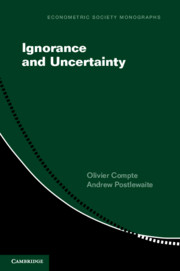Refine search
Actions for selected content:
2348 results in Statistical theory and methods

Ignorance and Uncertainty
-
- Published online:
- 30 November 2018
- Print publication:
- 13 December 2018
10 - Asymptotic theory
- from Part B - Estimation And Inference
-
- Book:
- Statistics
- Published online:
- 11 June 2020
- Print publication:
- 08 November 2018, pp 371-436
-
- Chapter
- Export citation
Part A - Probability and Distribution Theory
-
- Book:
- Statistics
- Published online:
- 11 June 2020
- Print publication:
- 08 November 2018, pp 1-2
-
- Chapter
- Export citation
4 - Special univariate distributions
- from Part A - Probability and Distribution Theory
-
- Book:
- Statistics
- Published online:
- 11 June 2020
- Print publication:
- 08 November 2018, pp 95-148
-
- Chapter
- Export citation
7 - Functions of random variables
- from Part A - Probability and Distribution Theory
-
- Book:
- Statistics
- Published online:
- 11 June 2020
- Print publication:
- 08 November 2018, pp 227-280
-
- Chapter
- Export citation
Appendix A - Some mathematical tools
-
- Book:
- Statistics
- Published online:
- 11 June 2020
- Print publication:
- 08 November 2018, pp 699-726
-
- Chapter
- Export citation
List of exercises
-
- Book:
- Statistics
- Published online:
- 11 June 2020
- Print publication:
- 08 November 2018, pp xi-xxii
-
- Chapter
- Export citation
3 - Expectations and their generating functions
- from Part A - Probability and Distribution Theory
-
- Book:
- Statistics
- Published online:
- 11 June 2020
- Print publication:
- 08 November 2018, pp 57-94
-
- Chapter
- Export citation
Contents
-
- Book:
- Statistics
- Published online:
- 11 June 2020
- Print publication:
- 08 November 2018, pp vii-x
-
- Chapter
- Export citation
Preface
-
- Book:
- Statistics
- Published online:
- 11 June 2020
- Print publication:
- 08 November 2018, pp xxvii-xxviii
-
- Chapter
- Export citation
Bibliography
-
- Book:
- Statistics
- Published online:
- 11 June 2020
- Print publication:
- 08 November 2018, pp 741-752
-
- Chapter
- Export citation
Dedication
-
- Book:
- Statistics
- Published online:
- 11 June 2020
- Print publication:
- 08 November 2018, pp v-vi
-
- Chapter
- Export citation
12 - Likelihood, information, and maximum likelihood estimation
- from Part B - Estimation And Inference
-
- Book:
- Statistics
- Published online:
- 11 June 2020
- Print publication:
- 08 November 2018, pp 485-550
-
- Chapter
- Export citation
Appendix B - Notation
-
- Book:
- Statistics
- Published online:
- 11 June 2020
- Print publication:
- 08 November 2018, pp 727-740
-
- Chapter
- Export citation
Part B - Estimation And Inference
-
- Book:
- Statistics
- Published online:
- 11 June 2020
- Print publication:
- 08 November 2018, pp 325-326
-
- Chapter
- Export citation
13 - Other methods of estimation
- from Part B - Estimation And Inference
-
- Book:
- Statistics
- Published online:
- 11 June 2020
- Print publication:
- 08 November 2018, pp 551-604
-
- Chapter
- Export citation
Frontmatter
-
- Book:
- Statistics
- Published online:
- 11 June 2020
- Print publication:
- 08 November 2018, pp i-iv
-
- Chapter
- Export citation
6 - Conditioning, dependence, and joint moments
- from Part A - Probability and Distribution Theory
-
- Book:
- Statistics
- Published online:
- 11 June 2020
- Print publication:
- 08 November 2018, pp 171-226
-
- Chapter
- Export citation
Preface to the Series
-
- Book:
- Statistics
- Published online:
- 11 June 2020
- Print publication:
- 08 November 2018, pp xxiii-xxvi
-
- Chapter
- Export citation
1 - Probability
- from Part A - Probability and Distribution Theory
-
- Book:
- Statistics
- Published online:
- 11 June 2020
- Print publication:
- 08 November 2018, pp 3-32
-
- Chapter
- Export citation
